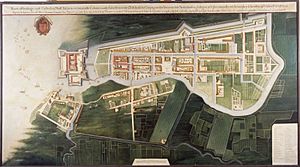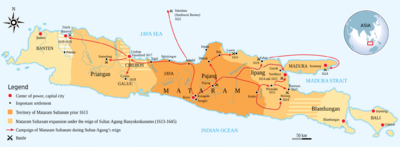Siege of Batavia facts for kids
Quick facts for kids Siege of Batavia |
|||||||
|---|---|---|---|---|---|---|---|
 Siege of Batavia by Sultan Agung in 1628 |
|||||||
|
|||||||
| Belligerents | |||||||
| Commanders and leaders | |||||||
| Sultan Agung of Mataram Marquess Bahureksa † |
Jan Pieterszoon Coen | ||||||
| Strength | |||||||
| 10,000 (first siege) 14,000 (second siege) |
500–800 including foreign mercenaries from Japan, China, India, Africa, the Moluccas, Celebes, and Java (first siege) ? (second siege) |
||||||
| Casualties and losses | |||||||
| more than 5,000 | small amount | ||||||
The Siege of Batavia was a big military effort led by Sultan Agung of the Mataram Sultanate. He wanted to take control of the Dutch port city called Batavia in Java. Sultan Agung tried to capture Batavia twice. The first try was in 1628, and the second was in 1629. Both attempts were not successful.
Contents
Why the Siege Happened
The Dutch East Indies Company (VOC) first set up their main base in the Ambon area. To grow their trade, the Dutch asked the Sultanate of Mataram for permission. Mataram was a powerful kingdom in Java at that time. The Dutch wanted to build trading posts, which were like small forts and warehouses, along Java's northern coast.
Dutch Settlements in Java
The second ruler of Mataram, Raden Mas Jolang, allowed the Dutch to build a trading post in Jepara in 1613. He might have hoped the Dutch would help him against his enemy, the city of Surabaya.
Later, the VOC, led by their important leader Jan Pieterszoon Coen, took over the port of Jacatra (now Jayakarta) from the Sultanate of Banten in 1619. They built a new town there called Batavia. This town became the main Dutch headquarters in Asia for the next 300 years. The Dutch did not want many Javanese people living in Batavia. They worried about an uprising if Javanese people became the majority. So, Batavia brought in many workers and slaves from other islands like the Maluku Islands and Bali.
Growing Tensions with Mataram
After almost ten years, Batavia became a big Dutch settlement and trading center in Java. This made the nearby Javanese kingdoms unhappy. They saw the European port as a foreign threat. The sultans of Banten wanted to take back the port city. They also wanted to stop Batavia from being a major trading rival. However, they were not strong enough to launch a big attack. They could only do small raids outside the city walls.
Meanwhile, in the east, Sultan Agung became the ruler of Mataram in 1613. He was one of Mataram's greatest leaders. His relationship with the Dutch Company became more difficult. In 1614, Sultan Agung warned the Dutch that peace would be hard to keep if they tried to conquer any part of Java. He wanted to be the only ruler of Java.
In 1618, a misunderstanding led to Mataram burning the VOC's trading post in Jepara. Three Dutch workers were killed, and others were arrested. The Dutch fleet then attacked Jepara, destroying most of the city. Despite this, the relationship was still mixed. Sultan Agung wanted the Dutch navy to help him against Surabaya. In 1621, he tried to make peace, and the Dutch sent representatives for the next three years. But the Dutch refused to give military help. Because of this, talks between the two sides stopped.
First Siege: August to December 1628
Sultan Agung likely started planning to conquer Batavia as early as 1626. Besides not liking the Dutch, taking Batavia was a step towards conquering Banten. Banten was the last major independent Javanese state. To prepare, he made an alliance with Cirebon, though Cirebon was mostly under Mataram's control.
Mataram's Attack Plan
In April 1628, Kyai Rangga Tapa, a leader from Tegal, went to Batavia. He offered a peace treaty with certain conditions from Mataram. The Dutch, however, said no to this offer. For Sultan Agung, this was the final straw. He decided to attack Batavia. He sent two groups of soldiers. One group went by sea, led by Tumenggung Bahureksa. The other group went by land, led by Prince Mandudareja.
On August 25, 1628, the first part of Sultan Agung's navy arrived in Batavia. The Mataram ships carried many supplies. These included 150 cattle, 5,900 bags of sugar, 26,600 coconuts, and 12,000 bags of rice. At first, they pretended they wanted permission to land and trade. But the large number of Mataram ships made the Dutch suspicious.
The next day, the Dutch allowed the cattle to be brought ashore. But only one Mataram ship could dock at a time. One hundred armed guards watched the landing from Batavia Castle. On the third day, three more Mataram ships arrived. They claimed they wanted permission to trade with Melaka. The Dutch leaders became more worried about the sudden increase in Mataram ships. They moved more cannons to the castle's northern walls.
Finally, that afternoon, twenty more Mataram ships arrived. They openly started unloading their troops north of the castle. The Dutch were now fully alerted. They pulled all their people back into the castle and began firing at the Javanese. To prevent the invading army from finding shelter, Coen ordered most of Batavia's bamboo houses outside the walls to be burned.
Fighting Begins
On August 28, 1628, 27 more Mataram ships entered the bay. But they landed far from Batavia. South of Batavia, the first part of the Mataram land army began to arrive. About 1,000 men started to put pressure on Batavia's southern side. On August 29, the first of many Mataram attacks happened. They attacked Fort Hollandia, southeast of the city. One hundred twenty Dutch soldiers managed to push back the attack. The Javanese suffered many losses. Several Dutch ships also arrived, bringing 200 more soldiers. This increased Batavia's defenders to 730 men.
The main part of the Mataram land army arrived in October. This brought their total strength to 10,000 men. They blocked all roads south and west of the city. They also tried to block the Ciliwung river to cut off the Dutch water supply. However, this did not help much. Repeated Mataram attacks on the Dutch defenses only led to heavy losses for them. Even worse, the Mataram commanders had not planned for a long siege. They were in an area with no local supplies. By December, the army was running out of food and other necessities.
Sultan Agung was angry about the lack of success. On December 2, he sent his executioners to punish Tumenggung Bahureksa and Prince Mandurareja. The next day, the Dutch found that their enemies had gone home. The Mataram army left behind 744 of their dead soldiers.
Second Siege: May to September 1629
After the failure of the first siege, Sultan Agung understood the main problem. It was hard to get supplies to Batavia because of the very long distance. His forces had to travel about 300 miles from their supply bases in Central Java. He decided to create many rice farming villages along the northern coast of Western Java. These villages stretched from Cirebon to Karawang. This led to the first large movement of Javanese people to this area. This area had been thinly populated before. Today, you can still see the vast rice fields from Cirebon to Indramayu, Karawang, and Bekasi. By May 1629, Mataram was ready for its second attack on Batavia.
New Plan, New Problems
The second invasion also had two groups of soldiers. One was the Sundanese army of Dipati Ukur, a leader from Priangan who was under Mataram's control. The other was the main Javanese army led by Adipati Juminah. Together, they had about 20,000 soldiers.
The original plan was for Ukur to wait for the main army in Priangan. Then, they would leave together in June. However, a lack of supplies forced Ukur to start his advance towards Batavia right away. When Juminah arrived in Priangan, he was angry that Ukur had not waited. The angry Mataram officials and soldiers caused trouble in Priangan. Hearing this news, Ukur quickly left the campaign. He even killed some Mataram officials who were with his group. Dipati Ukur knew that Sultan Agung would not forgive failure or betrayal. So, he decided to rebel against Mataram instead.
Illness and Retreat
The Mataram troops who arrived at Batavia were very tired. They lacked supplies and were suffering from malaria and cholera. Mataram soldiers set up a camp south of Batavia in an area now called Matraman. The Mataram forces surrounded Batavia. They also made Batavia's water supply dirty by polluting the Ciliwung River. This caused a cholera outbreak in Batavia. During this second siege, Jan Pieterszoon Coen suddenly died on September 21, 1629. It was most likely because of this cholera outbreak. With problems among their leaders, and suffering from illness and lack of supplies, the Mataram forces finally had to retreat.
What Happened Next
Dipati Ukur's decision to leave the campaign and rebel weakened Mataram's control over Priangan. This caused problems in West Java for several years. However, the Dutch were able to firmly establish themselves in Java. The failure to take Batavia made Sultan Agung change his plans. He decided to conquer areas to the east instead. He attacked Blitar, Panarukan, and Blambangan in Eastern Java. Blambangan was a vassal of the Balinese kingdom of Gelgel.
Because Sultan Agung was very strict about failure, many Javanese soldiers refused to go back home to Mataram. Many of them decided to marry local women and settle down in villages in northern West Java. This created the rice farming villages along the Pantura (north coast) region of West Java. This area includes Bekasi, Karawang, Subang, Indramayu, and Cirebon. The movement of Javanese people to Northern West Java created a unique culture. This culture later became quite different from the highland Sundanese and Central Javanese cultures.
In the years that followed, the VOC successfully grew its influence. They gained control of Buitenzorg and the Priangan highlands. They also took over Mataram's north coast ports like Tegal, Kendal, and Semarang. This happened mainly because of internal problems within the Mataram court. There were disputes over who would rule next and struggles for power. Some of the old Mataram army camps became place names in Jakarta today. You can recognize them by their original Javanese names, such as Matraman, Paseban, and Kampung Jawa.




